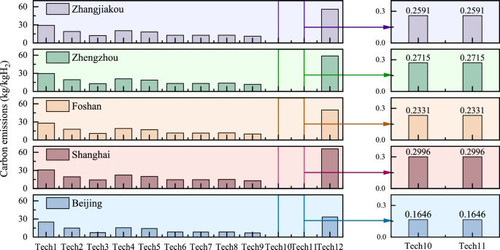Nature.com:Diversified hydrogen production methods can reduce C02 emissions and energy consumption across Chinese cities [View all]
 Fig. 1: Life cycle carbon dioxide emissions from different hydrogen production methods across Chinese cities.
Diversified hydrogen production methods can reduce carbon dioxide emissions and energy consumption across Chinese cities
Nature.com
Fig. 1: Life cycle carbon dioxide emissions from different hydrogen production methods across Chinese cities.
Diversified hydrogen production methods can reduce carbon dioxide emissions and energy consumption across Chinese cities
Nature.com | 17 June 2025
Abstract
It is still unclear about the emission reduction potential of different hydrogen production methods under different scenarios in China. Therefore,
this study quantifies and predicts the life cycle emission reduction potential of hydrogen energy across Chinese cities. Here we quantify the life cycle carbon dioxide emissions of different hydrogen production methods in 5 selected pilot cities. Additionally, we evaluate the respective contributions of blue hydrogen and green hydrogen to emission reductions under different scenarios. The results show that the implementation of diversified hydrogen production methods results in reductions in carbon dioxide emissions, ranging from 65% to 96%, when compared to the utilization of single coal gasification for hydrogen generation by the year 2060.
Blue hydrogen has the potential to achieve a emission reduction of 3.4 million tons by 2055. By 2050, green hydrogen is projected to constitute over 50% of the hydrogen supply market.
Introduction
Hydrogen energy serves as a clean, efficient, and renewable energy vector. With the serious challenge of global climate change and the urgent need for sustainable development, developing hydrogen energy has become one of the key technological pathways to achieve the goal of carbon neutrality. Low-emission hydrogen has emerged as a critical decarbonization pathway, offering transformative potential for achieving net-zero emissions across diverse sectors, including energy, transportation, and industrial processes. According to the 2024 Global Hydrogen Review published by the International Energy Agency, global hydrogen demand reached 97 million metric tons in 2023, representing a year-on-year increase of 2.5%.
In alignment with its decarbonization goals, China is actively developing diversified hydrogen production methods. By the end of 2023, China’s annual hydrogen production capacity exceeded 49 million tons, with a corresponding production exceeding 35 million tons10. The primary sources of hydrogen supply in China continue to be derived from coal, natural gas, and industrial by-products. Concurrently, electrolyzed water-derived hydrogen is steadily advancing with a capacity of 450,000 tons per year and an output reaching around 300,000 tons12,13,14. According to the Medium- and Long-Term Plan for the Development of the Hydrogen Energy Industry (2021–2035), it is projected that China’s hydrogen production from renewable energy sources will reach a scale of 100,000 tons/year to 200,000 tons/year by 202513. However, economic feasibility remains a challenge for hydrogen, as cost reductions are required to make it competitive with conventional fuels15,16. While actively developing hydrogen energy, China also needs to prioritize cleanliness, low-carbon attributes, and cost-effectiveness17,18,19. By developing diversified hydrogen production methods, it is possible to better reduce reliance on a single energy source, enhance energy efficiency and decrease carbon dioxide emissions...more
https://www.nature.com/articles/s43247-025-02452-5
IIRC "Nature.com" is HIGHLY Regarded by some here that bash hydrogen every time there's a H2 post so to those constantly attacking H2 posts: Complain to Nature.com. Running around with hair on fire complaining about the C02 levels and then attacking everything that tries to help is not productive at all and in fact is absurd and ridiculous. Sometimes hilarious and sad at the same time.
While 'Murikant's argue, China builds. They are now #1 in green. Who could have imagined that even 5 years ago.
美國人-你們不需要關稅,你們需要革命!
